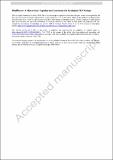| dc.contributor.author | Nordbotten, Jan M. | |
| dc.contributor.author | Fernø, Martin | |
| dc.contributor.author | Flemisch, Bernd | |
| dc.contributor.author | Juanes, Ruben | |
| dc.date.accessioned | 2025-06-17T14:38:47Z | |
| dc.date.available | 2025-06-17T14:38:47Z | |
| dc.date.issued | 2024-04-08 | |
| dc.identifier.uri | https://hdl.handle.net/1721.1/159426 | |
| dc.description.abstract | The original idea of constructing the FluidFlower was to construct an experimental laboratory that was well suited to both scientific research and public outreach. Indeed, a core principle was to allow for demonstrating the key physical mechanisms underpinning geological CO2 storage to the public in what can be perceived as a realistic setting. This motivated the design of a relatively large experiment (about 3 by 2 m), with a transparent glass plate, and where pH sensitive dye was used to mark the CO2 concentration in the water phase. With these dimensions, some geological complexity could be included in the experiment, and the use of high-permeable unconsolidated sands reduced the timescales to hours and days, as opposed to the years and centuries of relevance at field conditions.
The science part of the FluidFlower study was facilitated by the serendipitous arrival of the Covid-19 pandemic. We realized that the construction of the FluidFlower was at a scale and purpose which was quite unique, and that the travel restrictions imposed by Covid-19 allowed us to limit the insight non-local scientists would have in the experiments we conducted. This motivated the design of, and call for participation in, a forecasting study during spring 2021—and to our great fortune, good colleagues from around the globe agreed to participate.
The main part of the study took place from early fall 2021 through April 2022, and during this process, it quickly became clear that there was much more to be said about this study than what could fit within a single paper. The idea for creating the special issue you are now reading was thus formed. | en_US |
| dc.publisher | Springer Netherlands | en_US |
| dc.relation.isversionof | https://doi.org/10.1007/s11242-024-02067-y | en_US |
| dc.rights | Creative Commons Attribution-Noncommercial-ShareAlike | en_US |
| dc.rights.uri | http://creativecommons.org/licenses/by-nc-sa/4.0/ | en_US |
| dc.source | Springer Netherlands | en_US |
| dc.title | FluidFlower: A Meter-Scale Experimental Laboratory for Geological CO2 Storage | en_US |
| dc.type | Article | en_US |
| dc.identifier.citation | Nordbotten, J.M., Fernø, M., Flemisch, B. et al. FluidFlower: A Meter-Scale Experimental Laboratory for Geological CO2 Storage. Transp Porous Med 151, 859–863 (2024). | en_US |
| dc.contributor.department | Massachusetts Institute of Technology. Department of Civil and Environmental Engineering | en_US |
| dc.contributor.department | Massachusetts Institute of Technology. Department of Earth, Atmospheric, and Planetary Sciences | en_US |
| dc.relation.journal | Transport in Porous Media | en_US |
| dc.eprint.version | Author's final manuscript | en_US |
| dc.type.uri | http://purl.org/eprint/type/JournalArticle | en_US |
| eprint.status | http://purl.org/eprint/status/PeerReviewed | en_US |
| dc.date.updated | 2025-03-27T13:47:59Z | |
| dc.language.rfc3066 | en | |
| dc.rights.holder | The Author(s), under exclusive licence to Springer Nature B.V. | |
| dspace.embargo.terms | Y | |
| dspace.date.submission | 2025-03-27T13:47:59Z | |
| mit.journal.volume | 151 | en_US |
| mit.license | OPEN_ACCESS_POLICY | |
| mit.metadata.status | Authority Work and Publication Information Needed | en_US |
